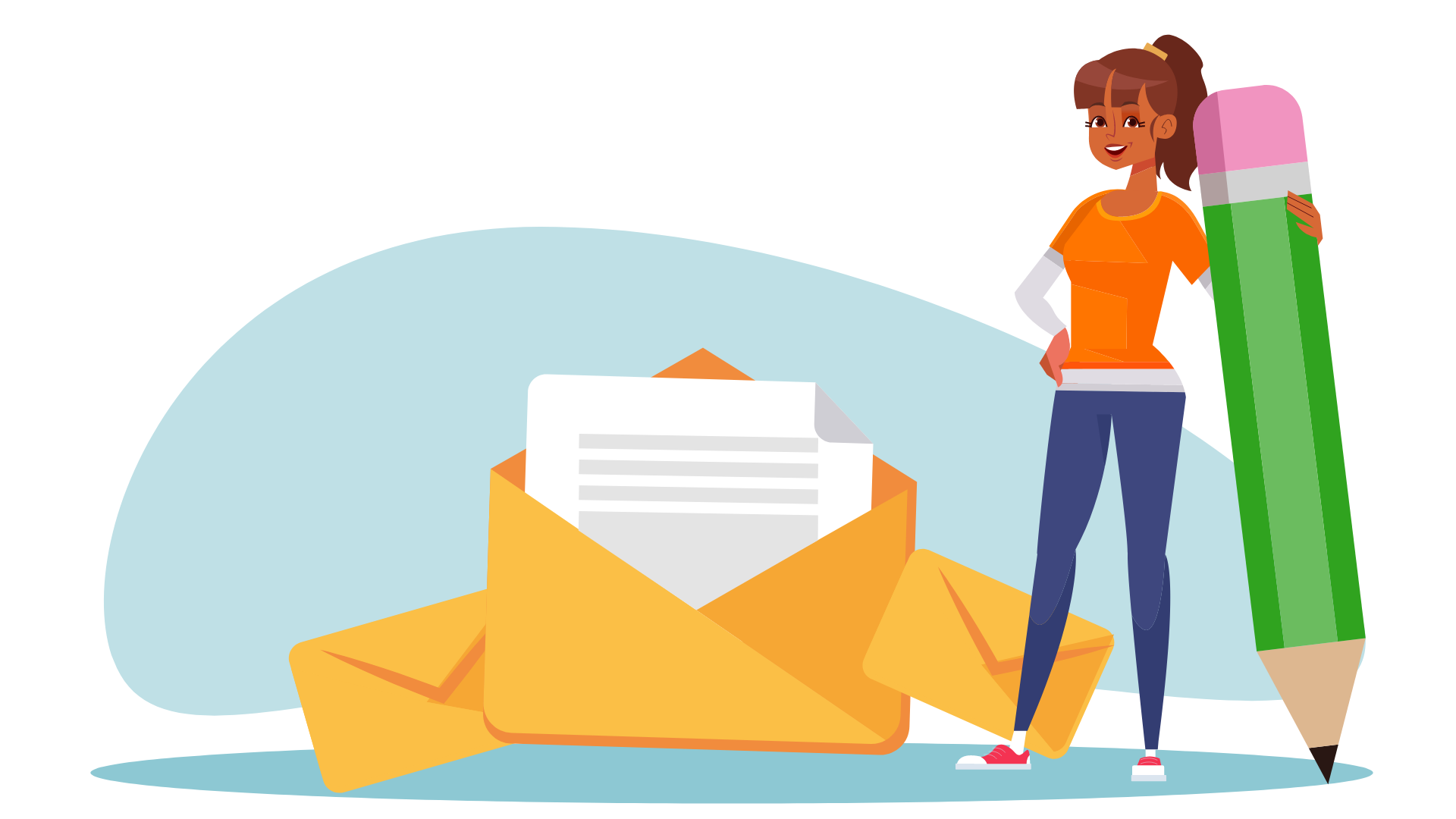If you’re new to email marketing, you’re in the right place. This guide walks you through everything you need to know to get started, from laying the groundwork to sending your first campaign. Let’s get rolling!
Why Email Marketing Works for Businesses of All Sizes
A High ROI Investment
Email marketing is basically sending emails to connect with your audience, whether it’s to share updates, promote products or services, or just stay on their radar. It’s affordable, effective, and one of the best ways to build relationships with your customers while boosting sales.
If you’re wondering how powerful email marketing really is, here’s the deal: it gives you an average return of $42 for every $1 you spend (Litmus). Pretty great, right? And it’s not just for big companies—81% (Emarsys ) of small businesses rely on email as their main way to get new customers. In fact, email is 40 times more effective than social media at bringing in new people (McKinsey & Company).
So, why is email marketing such a big deal? For starters, it’s more budget-friendly than running ads or pay-per-click campaigns. Plus, it’s direct—you don’t have to worry about algorithms messing with your reach like on social media. You own your email list, so you’re in full control of how and when you connect with your audience. Unlike social media posts that get lost in crowded feeds, emails go straight to your customers’ inboxes. This makes it more likely they will see and engage with them.
Evolving with Innovation for Greater Impact
Email marketing isn’t just effective – it’s also evolving in exciting ways. More businesses are using fun, interactive elements like quizzes, polls, and gamified emails to keep people engaged. AI tools are also shaking things up, helping create super-personalized subject lines and content that feels like it was written just for the reader. And since most people check their emails on their phones these days—over 55%, in fact—designing mobile-friendly emails is a must. On top of that, many brands are aligning their email campaigns with eco-friendly or socially conscious initiatives, which is a great way to connect with today’s values-driven consumers.
If you’re not already using email marketing, now’s the perfect time to start. It’s affordable and easy to scale as your audience grows. It provides plenty of ways to track what’s working through open rates, clicks, and other metrics. Plus, you can personalize your emails to speak directly to different groups of people, making your messages way more relevant and effective.
Email marketing is here to stay, and it’s a tool that businesses of all sizes can use to build stronger connections, grow their audience, and see real results. So, why not give it a try? It might just become your favorite marketing strategy.
Building Your Email Marketing Foundation
Setting Clear Goals
When you’re diving into email marketing, the first thing you’ll want to do is figure out exactly what you want to achieve. Are you looking to grow your subscriber list, drive traffic to your website, generate more sales or leads, or get your audience more engaged with your content? For example, 81% of small businesses rely on email to acquire customers, so setting clear goals will help you stay on track. With solid objectives, you can easily see what’s working and where to improve.
Choosing the Right Tools
Once you’ve got your goals in place, it’s time to pick an email marketing platform. There are lots of options out there, like Mailchimp, Klavio, and Contact Consumers, all designed to make your life easier. Choose a platform that’s easy to use, offers automation tools to save you time, and has good analytics to track your results. In fact, personalized emails can boost revenue by up to 760%, so using the right platform to personalize your messages can make a huge difference!
Growing Your Email List
Once you’ve got your platform set up, the next step is to start growing your email list. The best place to start is by adding a signup form to your website. Make sure it’s easy to spot, like on your homepage or blog. Many businesses also use pop-up forms or sticky bars that stay visible as people scroll. To get more signups, offer something in exchange for an email address. This could be an eBook, a template, or a special discount.Studies show that 56% of people are more likely to sign up if they get a useful freebie in return. You can also promote your signup form on social media, sharing a link and encouraging followers to join for exclusive offers. For example, if you run a clothing store, you might offer 10% off for the first purchase for new subscribers. If you host events or webinars, make sure to collect email addresses from attendees, so you can follow up afterward.
By setting clear goals, picking the right tools, and growing your email list, you’ll be ready to run email campaigns that really connect with your audience. Email marketing can deliver impressive results so starting with a solid foundation is key!
Creating a Strong Email Marketing Strategy
To kick off your email marketing the right way, you need to know who you’re talking to. Understanding your audience is super important. Start by figuring out things like their age, location, and interests—this will give you a good idea of who you’re speaking to. But it’s also important to dive into their pain points. What problems can you help them solve? By identifying these, you can create content that really resonates. Finally, think about what your audience enjoys receiving in their inbox. Do they prefer tips, special offers, or the latest updates? Understanding what they value will help you tailor your emails to what they actually want.
Once you’ve got a good understanding of your audience, it’s time to plan your content. Don’t be afraid to mix things up a bit. Send out newsletters with helpful updates and information that keep your audience in the loop. Promotional emails are great for offering exclusive deals and discounts. Educational emails can be really useful, too—think of tips, tutorials, or helpful resources. And don’t forget the event invites! Whether it’s a webinar, a big sale, or a new product launch, event emails can help build excitement and encourage people to get involved.
Now, let’s talk subject lines. Your subject line is the first thing people see, and it’s what will decide whether they open your email. Keep it short and sweet—under 60 characters is a good rule of thumb. Make sure it’s clear and specific, so people know exactly what to expect when they open the email. And make it engaging! Use action verbs or a little curiosity to get people interested in what you’ve got to say.
By getting to know your audience, planning out different types of content, and writing subject lines that catch attention, you’ll be well on your way to creating a solid email marketing strategy that works.
Designing and Sending Your Emails
When it comes to designing your emails, using templates is one of the easiest ways to get started. Most email marketing platforms offer drag-and-drop templates that make it simple to create beautiful emails without needing design skills. The key is to customize these templates to fit your brand. Make sure to incorporate your brand colors, logo, and overall style, so the email feels like an extension of your business. Also, keep in mind that a large portion of emails are opened on mobile devices, so it’s important to design your emails to be mobile-friendly. A clean, easy-to-read layout that adjusts well to different screen sizes is crucial for making sure your emails are user-friendly. Lastly, don’t forget to include a clear call-to-action (CTA) in your email. Whether you want readers to click a link, make a purchase, or sign up for something, a CTA helps guide them toward the next step.

To ensure your emails land in your subscribers’ inboxes and not the spam folder, it’s important to follow some best practices. First, use a recognizable sender name and email address—this helps build trust and makes it clear that your email is coming from a legitimate source. Avoid using all caps or excessive exclamation marks in your subject lines or content, as these are common red flags for spam filters. For subject lines, try to go for a transactional tone. Instead of saying “Our great summer collection just arrived,” try something like “Revisit your account to explore the new collection Friday after 4PM.” Another key tip is to maintain a good balance between text and images in your emails—too many images or too little text can both trigger spam filters. Also, avoid sending emails too frequently or without permission, as this can lead your recipients to flag your emails as spam. Always aim to keep your sending domain reputation high—your open and engagement rates should stay within industry averages. By following these best practices, you’ll improve your chances of staying out of the spam folder and getting your emails in front of your audience.
Before hitting send, always test your emails. Send test emails to yourself or your team to check how the email looks and functions. Make sure the formatting is correct and that your links and CTAs work as intended. It’s also a good idea to proofread for any typos or mistakes, as errors can make your email seem unprofessional. By taking the time to test your emails, you’ll ensure that everything looks great and functions properly before sending it to your audience.
With these steps in place—designing with templates, optimizing deliverability, and testing thoroughly—you’ll create great-looking emails. This ensures they reach your audience effectively.
Analyze and Improve Your Email Campaigns
Once your email campaign is sent out, it’s crucial to monitor its performance so you can continually improve. One of the first things you’ll want to track is your open rate—this tells you how many recipients actually opened your email. It’s a good indicator of how compelling your subject line and sender name were. Next, check your click-through rate (CTR), which shows how many people clicked on the links in your email. This helps you understand how engaging your content is and how effective your calls-to-action (CTAs) are. Another important metric is the number of unsubscribes. It’s normal to have a few unsubscribes after each campaign. However, a significant increase may mean your content isn’t resonating or you’re emailing too often.
To optimize your campaigns even further, consider running A/B tests. These tests allow you to experiment with different aspects of your emails, such as subject lines, email layouts, and CTAs. By testing variations and analyzing the results, you can learn what works best for your audience and fine-tune your approach for future campaigns.
Along with analyzing your metrics, it’s important to follow email marketing best practices and comply with regulations such as GDPR and CAN-SPAM. These laws set clear rules for how you should manage your email list and protect the privacy of your subscribers. One of the key aspects of compliance is managing your unsubscribe list properly. Make sure that every email you send includes an easy way for recipients to opt-out, and honor those requests promptly. Failing to do so not only violates laws but can also harm your sender reputation and increase the likelihood of your emails being marked as spam.
After gathering insights from your campaigns, it’s time to refine your strategy. Focus on what resonates most with your subscribers. Whether it’s specific types of content, certain subject lines, or particular CTAs, make adjustments based on the data you’ve collected. Continuously monitoring key metrics and running A/B tests helps you refine your email marketing efforts. Ensuring your emails comply with best practices and regulations increases your success over time.
Automate and Scale Your Email Marketing
Automation is a game-changer when it comes to saving time and keeping your email marketing consistent. Setting up automated campaigns allows you to connect with your audience at just the right moments without constant manual effort. For instance, a welcome series is a great way to greet new subscribers with a series of onboarding emails, introducing them to your brand and what you offer. Abandoned cart emails are highly effective for reminding users about the items they left behind. They often nudge customers to complete their purchases. Re-engagement campaigns help you reconnect with inactive subscribers. They show subscribers they’re valued and offer incentives to bring them back.
As your audience grows and your marketing goals expand, scaling your efforts becomes essential. Start by segmenting your email list to create hyper-targeted campaigns tailored to specific groups of subscribers. For example, you can send personalized offers to your most loyal customers or create content that speaks directly to the interests of a particular demographic. Integrating your email marketing platform with tools like CRMs or eCommerce platforms can streamline your processes. This helps you deliver even more personalized experiences.
Don’t forget to take advantage of seasonal or event-based campaigns as well. These are excellent opportunities to engage your audience with timely, relevant content that aligns with their current interests. By leveraging automation, you can scale your email marketing efforts effectively. Exploring advanced strategies helps you reach your audience in meaningful ways while staying efficient.
Final Thoughts
Starting with email marketing can feel overwhelming at first, but breaking it into manageable steps makes the process much easier. By focusing on delivering value, staying consistent, and fine-tuning your approach, you’ll gradually build a system that works. And the good news? You don’t have to rely solely on trial and error. Embarking on this journey doesn’t mean starting completely from scratch.
With AI on your side, it’s like having an experienced partner to guide you. AI helps streamline your efforts, offering insights and automating tasks so you can concentrate on what truly matters: building meaningful connections and growing your business. It ensures you stay efficient and effective, all while following best practices and complying with regulations.
The best part is you don’t need to be a seasoned pro to succeed. AI handles the complex parts, giving you the freedom to learn and improve with every campaign. Over time, you’ll transform email marketing into one of your most powerful tools for business growth.




